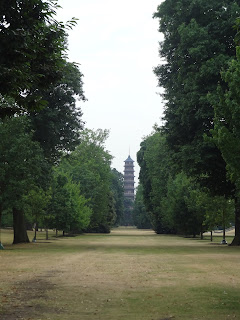
Continuous sunny weather in London, surely not…but this years English summer has provided plenty of it. Therefore, reluctant to spend time indoors (there will be plenty of rainy London days to go inside the museums), a 30 minute tube journey from the capitals centre took us to the Royal Botanical Gardens at Kew. Set within a massive 300 acre site “Kew Gardens” as it’s more commonly known, is home to world's largest collection of living plants with species from all around the globe. This UNESCO World Heritage Site as Spread across its grounds listed buildings such as the historical Glass Houses, a royal palace formerly inhabited by the late King George III as well as iconic structures like the Pagoda in the Japanese garden.
The extent of the site and its many attractions mean you may have to be selective on what you see if you are a one off day visitor. Although the Land train which circles round to stopping points should allow more of the area to be seen if large amounts of walking is an issue to anyone. For any energetic children in your party there are numerous opportunities for them to let off steam.An adventure play ground and indoor themed play areas give the adults a chance to rest weary limbs, although the boating pool may be a little more strenuous for some.
Across the year various exhibitions take place on site promoting different aspects of the plant world, currently running is the "IncrEdibles". Housed in the Victorian Palm House, this exhibit educates visitors on the wonders of all types of edible plants. Inside the wonderfully historical glass and wrought iron structure, decorative spiral staircases take you up to the high level walkways allowing a birds eye view of the foilage beneath. Dating back to the 1840's, the glass houses host a vast range of world wide vegetation in all forms of shapes and colours . It’s literally a walking, interactive encyclopedia of flora, allowing kids in particular to learn about the different species through colourful hands-on quiz boards as well as offering the chance to feel and in some cases, smell them.



The more modern Princess of Wales conservatory hosts 10 different climate zones each with controlling temperatures suited to the various plant life within it. From the desert like temperatures of the cacti room, to the more humid heat of the rain forest, though to the swamp area, trees and ferns can be observed at close hand. Keep your eyes open for a surprise encounter as we had when we came across a Water Dragon Lizard casually sitting amongst the vegetation. Apparently the reptiles earn their keep by being a natural pest control within the conservatory.
The largest of the Victorian glass houses is the Temperate House, although seemily barren of greenery on our visit, we later found out that a five year renovation is due to take place hence the scaling down of the plant life within. However it is still a marvellous structure to see, with the adjacent "Xstrata tree top" walk affording a particularly good view with descending Heathrow bound planes flying at low level in the background. At 60ft high, the walkway is a 200 metre trek around the top of a forest containing Chestnut and Oak trees offering great views across the gardens and out towards the London skyline.

Although not a massive gardening fan myself, I did find the visit thoroughly enjoyable and
interesting, particularly the use of the information boards, showing how the plants relate to your own life such as production of coffee beans from seed to your mug. The great thing about Kew is that each of the seasons will offer a different experience as the various plant life encounters the conditions it thrives in. This summer visit had allowed us to see the flower beds in full bloom but a return visit to see the autumnal reds, browns and golds of the trees foilage would be just as spectacular.

Following the short walk back to Kew Gardens underground station you’re greeted with a range of small independent shops to browse round and an outdoor sitting area at the Railway inn to get some well deserved refreshment. After all it’s not just the plants that need regular watering.
interesting, particularly the use of the information boards, showing how the plants relate to your own life such as production of coffee beans from seed to your mug. The great thing about Kew is that each of the seasons will offer a different experience as the various plant life encounters the conditions it thrives in. This summer visit had allowed us to see the flower beds in full bloom but a return visit to see the autumnal reds, browns and golds of the trees foilage would be just as spectacular.

Following the short walk back to Kew Gardens underground station you’re greeted with a range of small independent shops to browse round and an outdoor sitting area at the Railway inn to get some well deserved refreshment. After all it’s not just the plants that need regular watering.








I missed this last time I visited London, but I'll be sure to check it out next time :)
ReplyDelete